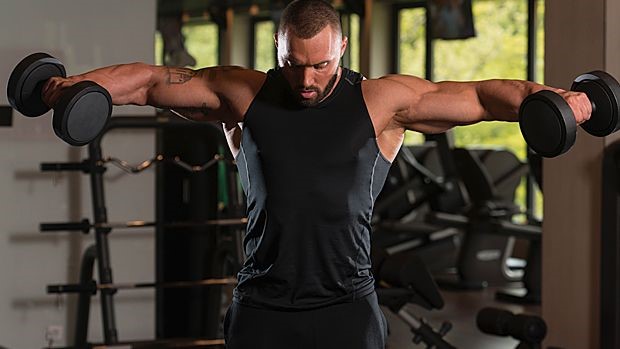Richardbrown
Approved Source

Larger delts are a top priority for all lifters since they give the appearance of a smaller waist, enhance the separation of the upper arm from the lower arm, and add the type of shoulder cap that indicates you're a serious lifter. Your clothes' slight added stretch too, perhaps? That is what I'm referring to!
You might be beginning your shoulder workout with overhead presses like many lifters do. It works. The greatest technique to isolate the middle delts in the lateral (side) plane, however, is to include lateral-raise exercises.
Lateral raises are hugely popular, and frequently doing them incorrectly in several ways. Here are 6 ways to mess up the standing dumbbell lateral raise, the most popular variant.
Mistake 1: Altering the Angle of Your Elbow Throughout the Movement
When performing a lateral raise correctly, you should bend your elbows just slightly and keep them bent for the duration of the set. Your elbows should maintain the same angle at the peak and bottom of each rep.
The isolation of the middle-delts will be compromised if you begin opening and closing at the elbows, which will involve the triceps. The weights should ideally follow more of an arc as you raise them rather than a straight line. Watch yourself or have someone else watch you while you make this action; if you're paying attention, it's not difficult to fix the mistake.
Mistake 2: Lowering the Weight Too Low
Keeping the middle delts tense during each rep is the best strategy to develop these target muscles. You are not placing any stress on your delts at all if you lower your hand all the way down till it is hanging by your side or in front of your leg.
Furthermore, the supraspinatus, a rotator cuff muscle, starts the movement before the middle delt head when you begin lifting from this fully extended position. This indicates that your target muscles aren't being worked during the initial degrees of your raise.
Stopping the movement with your hand a few inches from your side is your best option. This will make it little more difficult to bring the weight back up, which is what you want, right? Lower the weight all the way if you do want to work your supraspinatus a little. But when you lift it again, watch out for using too much force or moving erratically, both of which might result in harm.
Mistake 3: Leading with Your Wrists
Beginners frequently make the error of wagging the weights up and down without extending their elbows. In that regard, the upper arms don't have a wide range of motion, which can negate your gains in the middle delts. You should constantly "lead with your elbows" to ensure that they complete the whole range of motion.
The advantages of this middle-delt movement are essentially lost if your elbows don't move much. Your elbows are only approximately halfway up, even though your hand is where it should be at the top. Always lead with your elbows, okay?
Mistake 4: Only Raising to Shoulder Height
Even though the middle delt's range of motion extends further aloft, people typically do lateral lifts to a height of roughly shoulder height. You can increase the amount of contraction in your middle delts by going up to a point about 45 degrees above parallel. (You'll also somewhat activate your upper traps.)
You'll probably need to reduce your weight when you can move above your shoulders. You might think about doing a few sets with bigger weights at shoulder level, then a few more with somewhat lighter weights at a 45-degree angle above parallel.
Lifting above your shoulders is usually not a smart idea if you have shoulder impingement or soreness. If this is a problem, consult a sports medicine physician before attempting to increase your range of motion.
Mistake 5: Extending Your Arms Fully While Locking Them
On rare occasions, you'll see someone performing lateral lifts with their arms fully extended. It appears as though the individual is attempting to form the letter T at the top of the movement. The elbow joints are under a ton of pressure from this full extension. It's never a good idea to lock out a joint during any activity.
Mistake 6: Locking Your Elbows in an L-Bend
It is a frequent misconception that if you bend your elbows strongly (approaching 90 degrees) as opposed to slightly, you can lift more weight during lateral raises. Yes, you can increase the weight, and yes, the range of motion in your upper arm will remain unchanged. But...
Physics' "lever arm" theory essentially states that a weight is harder to lift the farthest it is from your body. Consider that you can lift 35 pounds while performing lateral lifts with nearly completely extended arms. Then you begin performing the lifts with your arms bent at a 90-degree angle, and surprise, surprise, you can lift much more weight!
Try extending your arms a little further if you believe that the added weight indicates that you are becoming stronger. With that weight, are your reps still possible? Most likely not. That is physics' lever-arm law in action.








